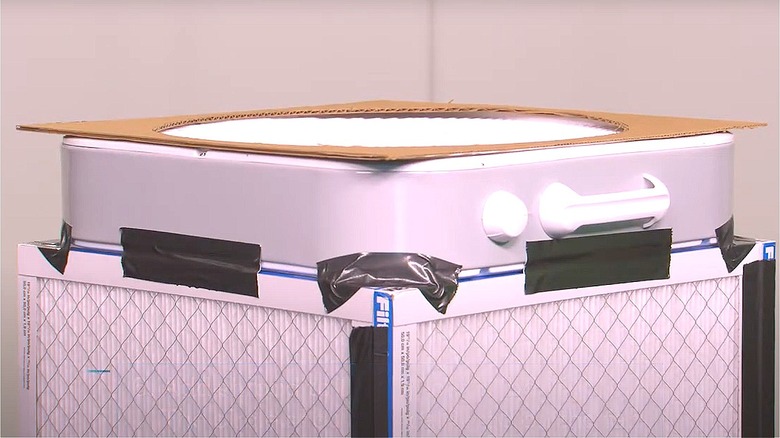What Is A Corsi-Rosenthal Cube And How Does It Purify Your Air?
The name Corsi-Rosenthal Cube sounds like a futuristic device that'll tell you your fate. In reality, a Corsi-Rosenthal Cube is a brilliant DIY air-purifying unit. The filtration system, created by Richard L. Corsi and Jim Rosenthal, has gained a lot of attention in the past few years as people grow more concerned with air quality. The boxes were designed to reduce the risk of airborne transmission of COVID-19, but they also proved beneficial during a period of intense wildfires and far-reaching smoke. Don't let the simplistic design fool you, the Corsi-Rosenthal Cube is a powerhouse in purifying.
According to research conducted by the University of California at Davis, Corsi-Rosenthal cubes are more effective than HEPA filters, a commonly used alternative. This means that improved air quality is but $100 and about an hour of DIY away. The cube's construction relies upon a box fan and four MERV 13 air filters held together by duct tape and supported by cardboard pieces. It's meant to be easy to build and simple to use so that it's accessible to everyone.
How the Corsi-Rosenthal Cube purifies air
During the height of the COVID-19 pandemic, Dr. Richard Corsi, current dean of the College of Engineering at UC Davis, and Jim Rosenthal, the CEO of Tex-Air Filters, devised an inexpensive way to filter out airborne bacteria. Their invention, the Corsi-Rosenthal Cube (or Corsi-Rosenthal Box), proved to be an effective way to reduce COVID-19 in the air. Further, a study conducted by Brown University found that the do-it-yourself air purifier also successfully lowered harmful chemicals like PFAs and phthalates in indoor spaces. It works just as well as traditional air purifiers, if not better in some cases.
The cube, consisting of four MERV 13 air filters and a box fan, draws air inward. The air passes through the filters that catch airborne bacteria particles like the ones known to cause the COVID-19 virus. Filtered air is then sucked out of the middle of the box by the fan and recirculated into the open room. According to Corsi, a properly built cube has a clean air delivery rate of 600 to 800 square feet per minute.
How to build a Corsi-Rosenthal Cube at home
The Corsi-Rosenthal Cube is an ingenious and inexpensive air purifier you can make at home. Its simple yet effective structure is easily built by even the most novice DIYers. To build one of your own, you'll need four MERV 13 air filters, a box fan, duct tape, scissors, and some cardboard from the fan box. The box fan and air filters should be 20-by-20 inches so they fit together in an aesthetically pleasing way. Cut the cardboard to match the same dimensions.
First, take notice of the arrow on each filter and the direction of the pleats. Turn the filters so that the pleats are vertical, not horizontal. Then, connect the filters in a square with all arrows pointing inward. This step is vital as the airflow needs to go into the box. Secure the corners and seal them with duct tape so that the frame is sturdy. No air should be able to pass through corner gaps.
Attach the cardboard piece to one of the open ends of the box, this will serve as the bottom. Once it's secure, turn the structure over and test its integrity. If it's sturdy, you can attach the box fan so that it blows air out of the cube. Again, air should go in through the sides and out through the fan. Secure the fan to the filters with duct tape and cardboard corner supports, if necessary.
